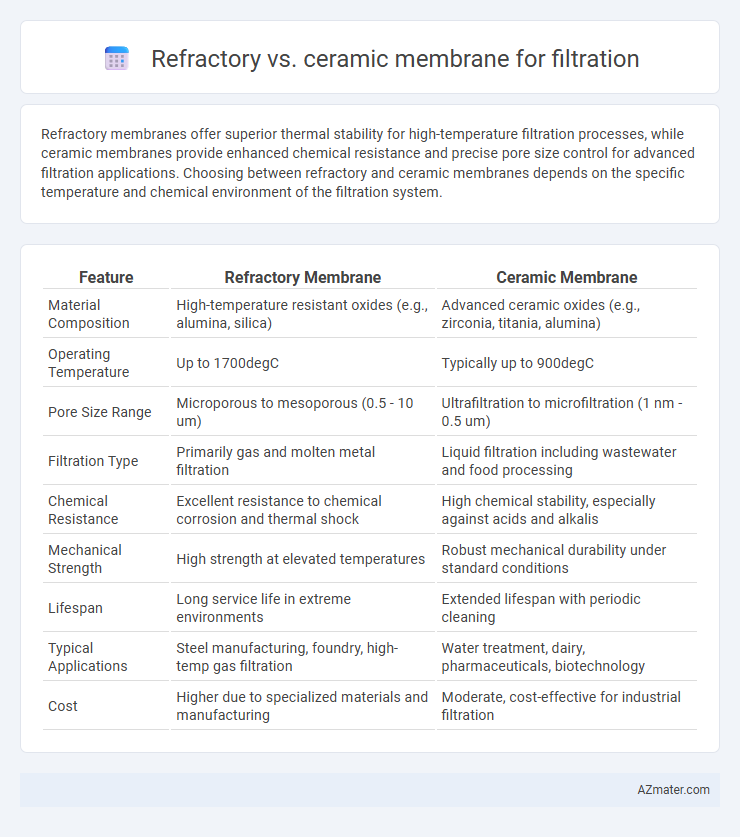Refractory membranes offer superior thermal stability for high-temperature filtration processes, while ceramic membranes provide enhanced chemical resistance and precise pore size control for advanced filtration applications. Choosing between refractory and ceramic membranes depends on the specific temperature and chemical environment of the filtration system.
Table of Comparison
| Feature | Refractory Membrane | Ceramic Membrane |
|---|---|---|
| Material Composition | High-temperature resistant oxides (e.g., alumina, silica) | Advanced ceramic oxides (e.g., zirconia, titania, alumina) |
| Operating Temperature | Up to 1700degC | Typically up to 900degC |
| Pore Size Range | Microporous to mesoporous (0.5 - 10 um) | Ultrafiltration to microfiltration (1 nm - 0.5 um) |
| Filtration Type | Primarily gas and molten metal filtration | Liquid filtration including wastewater and food processing |
| Chemical Resistance | Excellent resistance to chemical corrosion and thermal shock | High chemical stability, especially against acids and alkalis |
| Mechanical Strength | High strength at elevated temperatures | Robust mechanical durability under standard conditions |
| Lifespan | Long service life in extreme environments | Extended lifespan with periodic cleaning |
| Typical Applications | Steel manufacturing, foundry, high-temp gas filtration | Water treatment, dairy, pharmaceuticals, biotechnology |
| Cost | Higher due to specialized materials and manufacturing | Moderate, cost-effective for industrial filtration |
Introduction to Membrane Filtration Technologies
Membrane filtration technologies utilize selective barriers to separate particles and contaminants based on size, charge, and other properties, enhancing water and wastewater treatment efficiency. Refractory membranes, known for their high thermal and chemical resistance, are suitable for aggressive environments with elevated temperatures and corrosive media. Ceramic membranes, composed of inorganic materials like alumina or zirconia, provide superior durability, fouling resistance, and long operational life, making them ideal for industrial filtration applications requiring robustness and consistent performance.
Understanding Refractory Membranes
Refractory membranes are designed to withstand extremely high temperatures and corrosive environments, making them ideal for industrial filtration processes involving molten metals or harsh chemical reactions. These membranes consist of highly durable materials such as alumina, zirconia, or silicon carbide, providing excellent thermal stability and mechanical strength. Their porous structure enables efficient separation of solids from liquids or gases, ensuring long service life under extreme operating conditions.
Overview of Ceramic Membranes
Ceramic membranes offer high chemical and thermal resistance, making them ideal for aggressive filtration environments such as wastewater treatment and harsh chemical processing. Their porous structure enables precise separation of particles, bacteria, and contaminants with pore sizes typically ranging from microfiltration (0.1-10 microns) to ultrafiltration (0.01-0.1 microns). Compared to refractory membranes, ceramic membranes provide superior durability, longer lifespan, and ease of cleaning through backflushing or chemical cleaning methods.
Key Material Properties Compared
Refractory membranes exhibit superior thermal stability and resistance to chemical corrosion, making them ideal for high-temperature filtration applications, whereas ceramic membranes offer enhanced mechanical strength and porosity crucial for precise particle separation in water treatment. Key material properties such as pore size distribution, thermal expansion coefficient, and chemical inertness differentiate their filtration performance significantly. Refractory membranes typically feature alumina or zirconia bases with high melting points, while ceramic membranes use advanced oxides providing optimal filtration efficiency and durability under varying operational conditions.
Filtration Efficiency: Refractory vs Ceramic
Refractory membranes typically exhibit lower filtration efficiency compared to ceramic membranes due to their coarser pore structures and reduced chemical stability under aggressive conditions. Ceramic membranes offer superior filtration efficiency with precisely controlled pore sizes, enabling effective removal of fine particulates and contaminants from fluids. The enhanced durability and chemical inertness of ceramic membranes ensure consistent performance and longer service life in demanding filtration applications.
Chemical and Thermal Resistance Analysis
Refractory membranes exhibit superior thermal resistance, often withstanding temperatures above 1600degC, making them ideal for high-temperature filtration processes in harsh environments. Ceramic membranes provide excellent chemical resistance, particularly against acids and alkalis, due to their stable inorganic materials like alumina, zirconia, or silicon carbide. When selecting between refractory and ceramic membranes, consider the specific chemical exposure and temperature range to ensure optimal filtration performance and membrane longevity.
Durability and Lifespan Considerations
Refractory membranes exhibit exceptional durability due to their high resistance to thermal shock and chemical corrosion, making them ideal for harsh filtration environments with lifespans often exceeding several years. Ceramic membranes also offer strong durability, particularly in abrasive and high-temperature applications, but their lifespan may be shorter than refractory counterparts due to brittleness under mechanical stress. Selecting between refractory and ceramic membranes depends on specific operational conditions, balancing longevity with mechanical resilience and chemical stability for optimal filtration performance.
Cost and Economic Evaluation
Refractory membranes typically incur higher initial costs due to their durable materials and complex manufacturing processes, making them suitable for high-temperature applications with longer lifespans that justify the investment. Ceramic membranes, while also costly upfront, offer generally lower maintenance expenses and greater permeability, often leading to reduced operational costs over time through improved filtration efficiency. The economic evaluation favors ceramic membranes in scenarios prioritizing cost-effectiveness and ease of cleaning, whereas refractory membranes remain advantageous for demanding industrial environments requiring exceptional thermal and chemical resistance.
Common Applications and Industry Use Cases
Refractory membranes excel in high-temperature filtration processes, commonly used in steel manufacturing and cement production for filtering molten metals and hot gases. Ceramic membranes are favored in water treatment, food and beverage, and pharmaceutical industries due to their chemical resistance and ability to filter fine particles at moderate temperatures. Both technologies are critical in industrial applications requiring durability and precision, with refractory membranes suited for extreme heat environments and ceramic membranes optimized for chemical stability and fine filtration.
Choosing the Right Membrane: Factors to Consider
Selecting the appropriate membrane for filtration hinges on process temperature, chemical resistance, and fouling tendencies. Refractory membranes excel in high-temperature applications due to their thermal stability and mechanical strength, while ceramic membranes offer superior chemical resistance and precise pore size control for fine filtration. Evaluating feed characteristics, operational conditions, and maintenance requirements ensures optimal filtration performance and membrane lifespan.

Infographic: Refractory vs Ceramic membrane for Filtration
 azmater.com
azmater.com